Combined application of organic fertilizer and chemical fertilizer alleviates the kernel position effect in summer maize by promoting post-silking nitrogen uptake and dry matter accumulation
Lichao Zhai ,Lihua Zhang ,Yongzeng Cui ,Lifang Zhai ,Mengjing Zheng ,Yanrong Yao ,Jingting Zhang,Wanbin Hou,Liyong Wu,Xiuling Jia
1 Institute of Cereal and Oil Crops,Hebei Academy of Agriculture and Forestry Sciences/Key Laboratory of Crop Cultivation Physiology and Green Production of Hebei Province,Shijiazhuang 050035,China
2 Hebei Science and Technology Innovation Service Center,Shijiazhuang 050051,China
3 Yongnian Agricultural Technology Extension Center,Handan 057150,China
4 Ningjin Agricultural Technology Extension Center,Xingtai 055550,China
Abstract Adjusting agronomic measures to alleviate the kernel position effect in maize is important for ensuring high yields.In order to clarify whether the combined application of organic fertilizer and chemical fertilizer (CAOFCF) can alleviate the kernel position effect of summer maize,field experiments were conducted during the 2019 and 2020 growing seasons,and five treatments were assessed: CF,100% chemical fertilizer;OFCF1,15% organic fertilizer+85% chemical fertilizer;OFCF2,30% organic fertilizer+70% chemical fertilizer;OFCF3,45% organic fertilizer+55% chemical fertilizer;and OFCF4,60% organic fertilizer+40% chemical fertilizer.Compared with the CF treatment,the OFCF1 and OFCF2 treatments significantly alleviated the kernel position effect by increasing the weight ratio of inferior kernels to superior kernels and reducing the weight gap between the superior and inferior kernels.These effects were largely due to the improved filling and starch accumulation of inferior kernels.However,there were no obvious differences in the kernel position effect among plants treated with CF,OFCF3,or OFCF4 in most cases.Leaf area indexes,post-silking photosynthetic rates,and net assimilation rates were higher in plants treated with OFCF1 or OFCF2 than in those treated with CF,reflecting an enhanced photosynthetic capacity and improved postsilking dry matter accumulation (DMA) in the plants treated with OFCF1 or OFCF2.Compared with the CF treatment,the OFCF1 and OFCF2 treatments increased post-silking N uptake by 66.3 and 75.5%,respectively,which was the major factor driving post-silking photosynthetic capacity and DMA.Moreover,the increases in root DMA andzeatin riboside content observed following the OFCF1 and OFCF2 treatments resulted in reduced root senescence,which is associated with an increased post-silking N uptake.Analyses showed that post-silking N uptake,DMA,and grain yield in summer maize were negatively correlated with the kernel position effect.In conclusion,the combined application of 15-30% organic fertilizer and 70-85% chemical fertilizer alleviated the kernel position effect in summer maize by improving post-silking N uptake and DMA.These results provide new insights into how CAOFCF can be used to improve maize productivity.
Keywords: chemical fertilizer,dry mater accumulation,kernel position effect,N uptake,organic fertilizer
1.lntroduction
The kernel position effect is common in maize ears (i.e.,the inferior kernels located in the upper part of ear have a slower filling rate,insufficient filling and lower final grain weight,compared to those of the superior kernels located in the middle and lower parts of the ear) (Xuet al.2015).Inappropriate cultural practices or abiotic stress usually exacerbate this kernel position effect,and can even lead to the abortion of the inferior kernels,which seriously restrict the improvement of maize grain yield potential (Shenet al.2018;Yanet al.2018).Therefore,exploring cultural practices to alleviate the kernel position effect of maize in high-yielding and high-efficiency production is of great significance.
Among the cultural practices in maize production,optimizing fertilizer management is a key measure for regulating grain filling and grain yield in maize (Mueller and Vyn 2018;Wuet al.2022).Since organic fertilizers have advantages over chemical fertilizers in regulating soil quality,applying organic fertilizer in field crop production is gaining more attention in recent years in China (Fanget al.2021;Renet al.2021;Hayatuet al.2022).However,if organic fertilizer is applied alone,it may be unable to meet the nutrient requirements of crop plants due to the slow-release of its nutrients,which ultimately affects the crop yield.In this context,combined application of organic fertilizer and chemical fertilizer (CAOFCF) is considered an effective fertilization measure for sustainable crop production.
Numerous studies have reported that CAOFCF is beneficial for crop yield improvement (Lvet al.2020;Xuet al.2021;Aluochet al.2022;Liu H Wet al.2022;Zhaiet al.2022;Zhang W Tet al.2022).However,most of these studies suggested that the increase in crop yield under CAOFCF treatments was closely related to changes in the soil properties,and there is a lack of information on the in-depth and systematic analysis of the mechanism of yield improvement from the perspective of plant physiology,especially from the perspective of kernel development.It is widely known that increasing plant dry matter accumulation (DMA),especially the postsilking DMA,is an important guarantee for good grain filling and a higher grain yield in maize (Ninget al.2013;Yanget al.2020;Wanget al.2021).Compared with applying chemical fertilizer alone,previous studies have demonstrated that CAOFCF can effectively promote crop DMA at the same N rate (Liet al.2018;Zhaiet al.2022).Saikiaet al.(2015) reported that CAOFCF enhanced wheat carbon assimilation by improving the photosynthetic rate during the reproductive stages,and Zhaiet al.(2022) found that CAOFCF is beneficial for the post-silking leaf area duration and photosynthetic capacity of maize.Therefore,the higher DMA under CAOFCF treatments may be associated with an enhanced photosynthetic capacity.In addition,increasing post-silking N uptake is essential for maintaining higher productivity in maize (Muet al.2015;Caoet al.2021),because post-silking N accumulation is associated with green leaf persistence,which in turn affects the photosynthetic capacity and biomass production.Huanget al.(2022) suggested that substituting organic nitrogen for 30% of the chemical N rate significantly increased the N uptake of banana.Similar improvements in N uptake in cereal crops have also been observed under reasonable CAOFCF treatments,including maize,wheat,and rice (Wanget al.2022;Zhaiet al.2022;Fanet al.2023).Recently,increasing evidence has shown that CAOFCF was beneficial for mitigating the soil reactive N losses by affecting the conversion of N in the soil (Xiaet al.2017;Tanget al.2019;Weiet al.2021;Li Y Wet al.2022),which can increase the soil N availability and facilitate N uptake by crop plants.Moreover,a strong root system is essential for plant nutrient uptake.Many studies have confirmed that the higher nutrient accumulation in plants and crop productivity under CAOFCF treatments are associated with the improved root system (Chenet al.2021;Rameshaet al.2021).Therefore,the improved root system driven by organic fertilizer application may be the key to the higher plant N uptake.
Post-silking assimilate accumulation is generally known as the main material source for grain filling in maize.The poor grain filling of inferior kernels resulting from an insufficient assimilate supply is a major reason for the aggravated kernel position effect of maize (Shenet al.2018).Thus,maintaining higher post-silking photosynthetic capacity and DMA by regulating postsilking N uptake may be the key for alleviating the kernel position effect of maize.In this study,we hypothesized that the combined application of organic fertilizer and chemical fertilizer in a reasonable proportion would be conducive to alleviating the kernel position effect by improving the filling of inferior kernels,which is closely related to its role in regulating post-silking N uptake and DMA.To test this hypothesis,a 2-year field experiment was conducted with the three objectives of (1) evaluating the impact of CAOFCF on grain filling and carbohydrate accumulation in the inferior and superior kernels,and on the kernel position effect in summer maize;(2) investigating the effect of CAOFCF on the post-silking N uptake,photosynthetic capacity,and DMA;and (3) analyzing the relationships of the kernel position effect with post-silking N uptake,DMA,and grain yield in summer maize.
2.Materials and methods
2.1.Experimental site and meteorological conditions
Field experiments were conducted during the 2019 and 2020 growing seasons at the Scientific Observing and Experimental Station of Crop Cultivation in the North China Plain,Institute of Cereal and Oil Crops,Hebei Academy of Agriculture and Forestry Sciences,Shijiazhuang,Hebei Province,China (37°95´N,114°71´E).This experimental site is characterized by a warm temperate sub-humid continental monsoon climate.The mean annual air temperature is 12.8°C and the mean precipitation level is 484 mm (rainfall plus snowfall).The primary soil in the area is meadow cinnamon soil,with the soil nutrients in the upper 0-20-cm soil profile comprising 1.57% organic matter,1.04 g kg-1total N,80 mg kg-1available N,21.4 mg kg-1available phosphorus (P),and 113.9 mg kg-1available potassium (K) before sowing in the 2019 growing season.The daily meteorological data for the two growing seasons are shown in Fig.1.
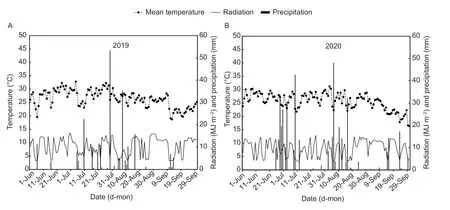
Fig.1 Daily mean temperature and precipitation data during 2019 and 2020 growing seasons.
2.2.Experimental design and management
The maize cultivar Yudan 9953 (YD9953),which is widely cultivated in the North China Plain,was used as the material for the field experiments,in which a random block design was employed.There were five treatments: CF,chemical NPK fertilizer;OFCF1,co-application of 15% OF and 85% CF;OFCF2,co-application of 30% OF and 70% CF;OFCF3,co-application of 45% OF and 55% CF;and OFCF4,co-application of 60% OF and 40% CF.All treatments included 225 kg ha-1N,120 kg ha-1P2O5,and 120 kg ha-1K2O,so the total N,P2O5,and K2O provided by the chemical fertilizer and organic fertilizer remained constant for all treatments.The organic fertilizer used in this study was produced from cow manure and contained 45% organic matter,2.48% N,0.27% P2O5,and 0.96% K2O.All CAOFCF treatments in this study involved replacing part of the chemical fertilizer with organic fertilizer while maintaining an equal N rate.First,the application amounts of organic fertilizer and chemical N fertilizer were calculated according to the principle of equal N rate substitution.Second,the P2O5and K2O amounts contained in the organic fertilizer were also calculated according to their nutrient contents.Third,the actual application amounts of P2O5and K2O in the chemical fertilizer were 120 kg ha-1minus their amounts contained in the organic fertilizer.Detailed information of the calculated application amounts of fertilizers for all treatments is shown in Table 1.Each treatment was repeated three times,and the experimental plot size was 10 m×8 m.The row spacing in each plot was 60 cm and there was a 1.5-m-wide buffer zone between plots.In the 2019 and 2020 growing seasons,seeds were sown to create a planting density of 7.50×104plants ha-1,and all plots received a basal application of 135 kg ha-1N,120 kg ha-1P2O5,and 120 kg ha-1K2O,with 90 kg ha-1of N topdressing applied at the V8 (eight-leaf) stage.All organic fertilizer was applied as basal fertilizer.After the harvest of winter wheat,the wheat straw was crushed and returned to the field.The basal organic fertilizer and chemical fertilizer were manually spread on the surface of each experimental plot,and a rotary tiller with suppressive function was used to incorporate the fertilizers into the soil to a depth of 20 cm.Other field management procedures were the same as those used by local smallholder farmers.
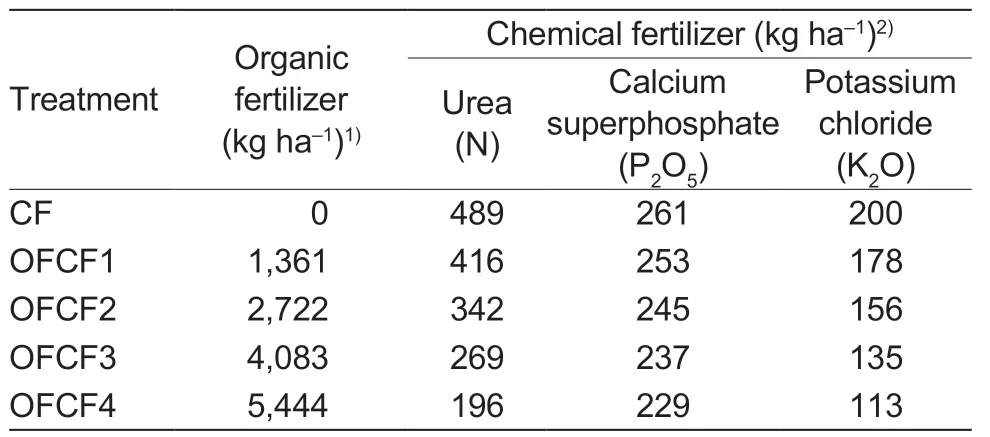
Table 1 Detailed descriptions of the amounts of organic fertilizer and chemical fertilizer applied in all treatments
2.3.Sampling and measurements
Grain filling and the kernel position effectAt the silking stage,80 uniform plants (i.e.,plants with similar plant height,ear height,stem diameter,and silking time) in each plot were tagged.Five ears from each tagged plant were sampled every 5 days from pollination untilphysiological maturity.A total of 100 kernels were removed from both the top (inferior kernels,i.e.,kernels of the upper third of the maize ear) and middle (superior kernels,i.e.,kernels of the middle third of the maize ear) parts of the ears.After the 100-kernel fresh weight was measured,each sample was dried at 70°C to a constant weight.The grain-filling process was fitted to Richard’s (1959) growth equation,as described by Zhuet al.(1988):
whereWis the kernel weight (mg),Ais the final grain weight (mg),tis the time after anthesis (days),andB,CandDare coefficients determined by regression.
In this study,we used the weight ratio of inferior kernels to superior kernels and the weight gap between the superior and inferior kernels as indexes for evaluating the kernel position effect in maize.These parameters were calculated using eqs.(3) and (4):
whereWRrepresents the weight ratio of inferior kernels to superior kernels andWGis the weight gap between the superior and inferior kernels;andIKWandSKWrepresent the inferior kernel weight and the superior kernel weight,respectively.The lower theWRvalue or higher theWGvalue,the greater the position effect.
Kernel starch and soluble sugar contentsAt physiological maturity,five ears were taken from each plot,the inferior and superior kernels were manually separated and then ground into power for the measurement of starch and soluble sugar contents.The starch and sugar contents of maize kernels were measured by using the acid hydrolysis method and anthrone colorimetry (Li and Li 2013),respectively.FlexStation 3 MultiMode microplate reader (Molecular Devices LLC,San Jose,CA,USA) was used to determine the absorption values of samples and blank controls at the 620 nm wavelength,and then the starch and sugar contents were calculated according to these absorption values.
Plant DMA and N accumulationAt silking and physiological maturity,five similar plants were selected from the middle of each plot.The plants were separated into stalks,leaves,sheaths,tassels,and ears,which were oven dried to obtain the dry weight of each part and the DMA.Post-silking DMA (t ha-1)=Total DMA at physiological maturity-Total DMA at silking
After measuring the DMA,the samples from each part were milled to a fine powder.Total N was extracted with H2SO4-H2O2and analyzed for total N content (%) with a continuous-flow autoanalyzer (AutoAnalyzer 3;Bran+Luebbe,Noderstedt,Germany).
Post-silking N uptake (g/plant)=Total N accumulation at physiological maturity-N accumulation at silking
Leaf area index (LAI),Pn,and net assimilation rate (NAR)Before the V6 stage,five representative plants were marked in each plot.Leaf lengths and the maximum leaf widths of all green leaves were measured at the V6 (6-leaf stage),V12 (12-leaf stage),R1 (silking stage),R3 (milking stage),and R6 (physiological maturity) stages.Leaf area and LAI were calculated as follows:
Pnwas measured at silking and 25 days after pollination (DAP) in 2019;and at silking,25 and 45 DAP in 2020.Measurements were taken from five randomly selected ear leaves on sunny days between 10:00 a.m.and 11:30 a.m.using a Li-6400 portable photosynthesis system (LI-COR Biosciences,Lincoln,NE,USA).NAR (g m-2d-1) was calculated using eq.(5) (Poweret al.1967):
whereL1andL2are the single plant leaf areas from the maize cultivars att1andt2,respectively;andW1andW2are the above-ground dry matter weights att1andt2,respectively.
Root DMA and hormone contentsPlant roots were collected from a soil depth of 0-40 cm.At the mid-grainfilling stage,three similar plants were selected from the middle of each plot for root sampling.Boundaries were defined separately based on the area occupied by each plant,i.e.,half of the distance between each row on either side of the base of each plant,and half of the distance between each plant in a row.Soil and root samples were collected separately from the 0-10,10-20,and 20-40 cm layers.Samples from each layer were numbered and placed in separate nylon bags;the roots were then washed and oven dried to measure root dry matter.Fresh root samples were also collected from three plants to measure the root hormone contents.The abscisic acid (ABA) and zeatin riboside (ZR) contents were measured using high-performance liquid chromatography,as described by Hanet al.(2011).
Grain yieldAt physiological maturity,all plants in a 4 m×2 m area containing the middle rows of each plot were harvested,and the grain yield was determined under the condition of 14% grain water content.
2.4.Data analyses
Statistical analyses were performed using SPSS software (ver.19.0;SPSS Inc.,Chicago,IL,USA) and graphs were analyzed using either SigmaPlot (ver.12.0;Systat,Inc.,San Jose,CA,USA) or Microsoft Excel software (ver.2016;Microsoft Corp.,Redmond,WA,USA).Oneway analysis of variance followed by Tukey’s test,and treatment means were compared by calculating the least significant differences (LSDs) to identify significant differences at the 0.05 probability level.
3.Results
3.1.Kernel weight gap and weight ratio
In both growing seasons,the weight gaps between superior and inferior kernels were significantly lower in OFCF1 and OFCF2 plants than in CF plants (Fig.2-A).The OFCF1 and OFCF2 treatments reduced the kernel weight gaps by 59.2 and 43.7%,respectively,compared with the CF treatment.Similarly,the CAOFCF treatments significantly affected the weight ratios of inferior kernels to superior kernels in both growing seasons (Fig.2-B).In the 2019 growing season,the OFCF1,OFCF2,OFCF3,and OFCF4 treatments increased the weight ratios of inferior kernels to superior kernels by 15.5,10.4,7.3,and 9.7%,respectively,compared with the CF treatment;and significant differences from the CF treatment were observed for OFCF1,OFCF2,and OFCF4.In the 2020 growing season,the OFCF1,OFCF2,OFCF3,and OFCF4 treatments significantly increased the weight ratios of inferior kernels to superior kernels by 8.1,8.1,10.5,and 7.0%,respectively,compared with the CF treatment.

Fig.2 Kernel weight gaps between superior kernels and inferior kernels (A and C) and weight ratios of inferior to superior kernels (B and D) of summer maize under different treatments.OF,organic fertilizer;CF,chemical NPK fertilizer;OFCF1,co-application of 15% OF and 85% CF;OFCF2,co-application of 30% OF and 70% CF;OFCF3,co-application of 45% OF and 55% CF;OFCF4,co-application of 60% OF and 40% CF.Bars mean SD (n=3).Different lowercase letters above a column indicate significant differences among treatments (P<0.05).
3.2.Grain filling and grain-filling rate
The grain-filling process in summer maize was affected by CAOFCF treatments,especially for the inferior kernels (Fig.3).In 2019,differences were observed for the inferior and superior kernel weights from 30 and 40 DAP,respectively.The differences in kernel weights between CAOFCF and CF plants increased gradually over time.The OFCF1,OFCF2,OFCF3,and OFCF4 treatments increased the final inferior kernel weights by 24.3,20.2,9.7,and 4.0%,respectively,compared with the CF treatment.The final superior kernel weights in OFCF1 and OFCF2 plants were 7.8 and 7.7% greater than those in CF plants,respectively,but the OFCF4 treatment reduced kernel weight by 5.7%,compared with the CF treatment.The maximum filling rate for inferior kernels in CF plants was observed at 15 DAP;however,CAOFCF treatments delayed the maximum filling rate for inferior kernels by 5 days.OFCF1,OFCF2,OFCF3,and OFCF4 increased the filling rates for inferior kernels by 24.9,20.7,9.7,and 3.7%,respectively,compared with CF.For superior kernels,all treatments resulted in the maximum grain-filling rates at 20 DAP.The filling rates of superior kernels in OFCF1,OFCF2,and OFCF3 plants were 7.9,7.9,and 0.4% greater than those in CF plants,respectively,but the CFOF4 treatment reduced the grainfilling rate by 5.5% compared with the CF treatment.
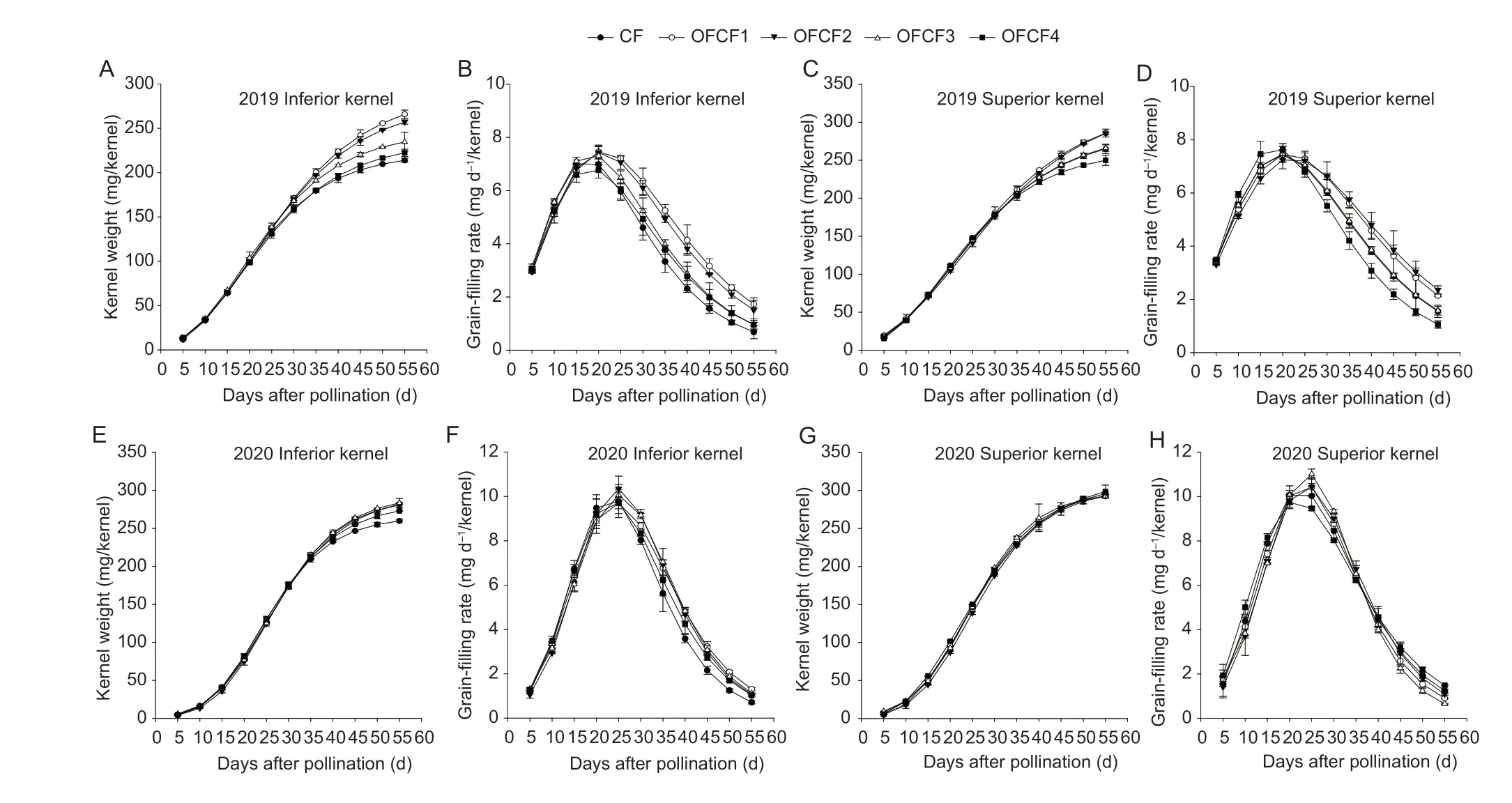
Fig.3 Effects of combined application of organic fertilizer and chemical fertilizer (CAOFCF) on dynamic changes in kernel weight (A,C,E,and G) and the grain-filling rates (B,D,F,and H) of inferior and superior kernels in summer maize.OF,organic fertilizer;CF,chemical NPK fertilizer;OFCF1,co-application of 15% OF and 85% CF;OFCF2,co-application of 30% OF and 70% CF;OFCF3,co-application of 45% OF and 55% CF;OFCF4,co-application of 60% OF and 40% CF.Bars mean SD (n=3).
In 2020,the CAOFCF treatments increased inferior kernel weights from 40 DAP compared with the CF treatment.The final inferior kernel weights in OFCF1,OFCF2,OFCF3,and OFCF4 plants were 8.5,8.1,9.1,and 5.1% greater than those in CF plants,respectively.However,no significant differences in superior kernel weights were observed during the grain-filling process.For inferior kernels,all treatments resulted in maximum grain-filling rates at 25 DAP.The grain-filling rates of inferior kernels in OFCF1,OFCF2,OFCF3,and OFCF4 plants were 8.9,8.4,8.9,and 5.3% greater than in CF plants,respectively.For superior kernels,the maximum grain-filling rates were observed in OFCF1,OFCF2,and OFCF3 plants at 25 DAP,but in CF and OFCF4 plants at 20 DAP.For superior kernels,there were no obvious differences in grain-filling rates among the treatments.
3.3.Starch and soluble sugar contents
As shown in Fig.4,the starch and soluble sugar contents in superior kernels were higher than those in inferior kernels under each treatment.In 2019,compared with CF,OFCF1 and OFCF2 increased the starch contents in inferior and superior kernels by 7.4 and 7.7% (P<0.05) and by 2.4 and 3.2%,respectively.OFCF1 and OFCF2 increased the soluble sugar contents in inferior and superior kernels by 11.2 and 10.8% (P<0.05) and by 6.3 and 5.3%,respectively.However,the differences in the starch and soluble sugar contents among CF,OFCF3,and OFCF4 were not obvious in most cases.

Fig.4 Effects of combined application of organic fertilizer and chemical fertilizer (CAOFCF) treatments on the kernel starch contents (A and C) and soluble sugar contents (B and D) in inferior and superior kernels.OF,organic fertilizer;CF,chemical NPK fertilizer;OFCF1,co-application of 15% OF and 85% CF;OFCF2,co-application of 30% OF and 70% CF;OFCF3,co-application of 45% OF and 55% CF;OFCF4,co-application of 60% OF and 40% CF.Bars mean SD (n=3).Different lowercase letters above the bars representing the same kernel type indicate significant differences among treatments at P<0.05.
In 2020,the starch contents in inferior kernels under OFCF1,OFCF2,and OFCF3 were 5.6,4.7,and 3.3% higher than that of CF (P<0.05);and the differences in starch contents in superior kernels among CF,OFCF1,OFCF2,and OFCF3 were not obvious.However,OFCF4 significantly reduced the starch contents in inferior and superior kernels,compared to that of CF.Compared with CF,OFCF1 and OFCF2 increased the soluble sugar contents in inferior kernels by 10.5 and 17.2% (P<0.05),respectively;and OFCF1,OFCF2,and OFCF3 increased the soluble sugar contents in superior kernels by 19.4,16.6,and 9.2% (P<0.05),respectively.The differences in soluble sugar contents in the inferior and superior kernels between CF and OFCF4 were not significant.
3.4.LAI,post-silking Pn,and NAR
CAOFCF had considerable effects on LAI,post-silkingPn,and NAR in summer maize (Fig.5).For all treatments,LAI was the maximal at the R1 stage,and decreased gradually thereafter.In the 2019 growing season,the maximum LAI of CF plants was significantly greater than those of all the CAOFCF treatment plants,but it decreased rapidly during the grain-filling period.The LAIs of OFCF1,OFCF2,and OFCF3 plants were greater than those of CF plants at the R3 and R6 stages,and significant differences were observed at the R6 stage (P<0.01).In the 2020 growing season,the LAIs of OFCF1,OFCF2,and OFCF3 plants were greater than those of CF plants after the V12 stage;and significant differences were observed at the V12,R1,and R6 stages (P<0.05).In both growing seasons,thePnvalues were greater in OFCF1 and OFCF2 plants than in CF plants after anthesis;however,significant differences were only observed in OFCF2 plants at the M-GF and L-GF stages (P<0.05).In the 2019 growing season,OFCF1,OFCF2,and OFCF3 plants exhibited increases in the post-silking NAR of 6.8,7.6,and 21.7%,respectively,compared with CF plants;however,there was no obvious difference between CF and OFCF4 plants.In the 2020 growing season,OFCF2 plants exhibited a significant increase in NAR of 6.9%,compared with CF plants;however,there were no obvious differences among the CF,OFCF1,and OFCF4 plants.The NAR of OFCF3 plants was significantly lower than that of CF plants.
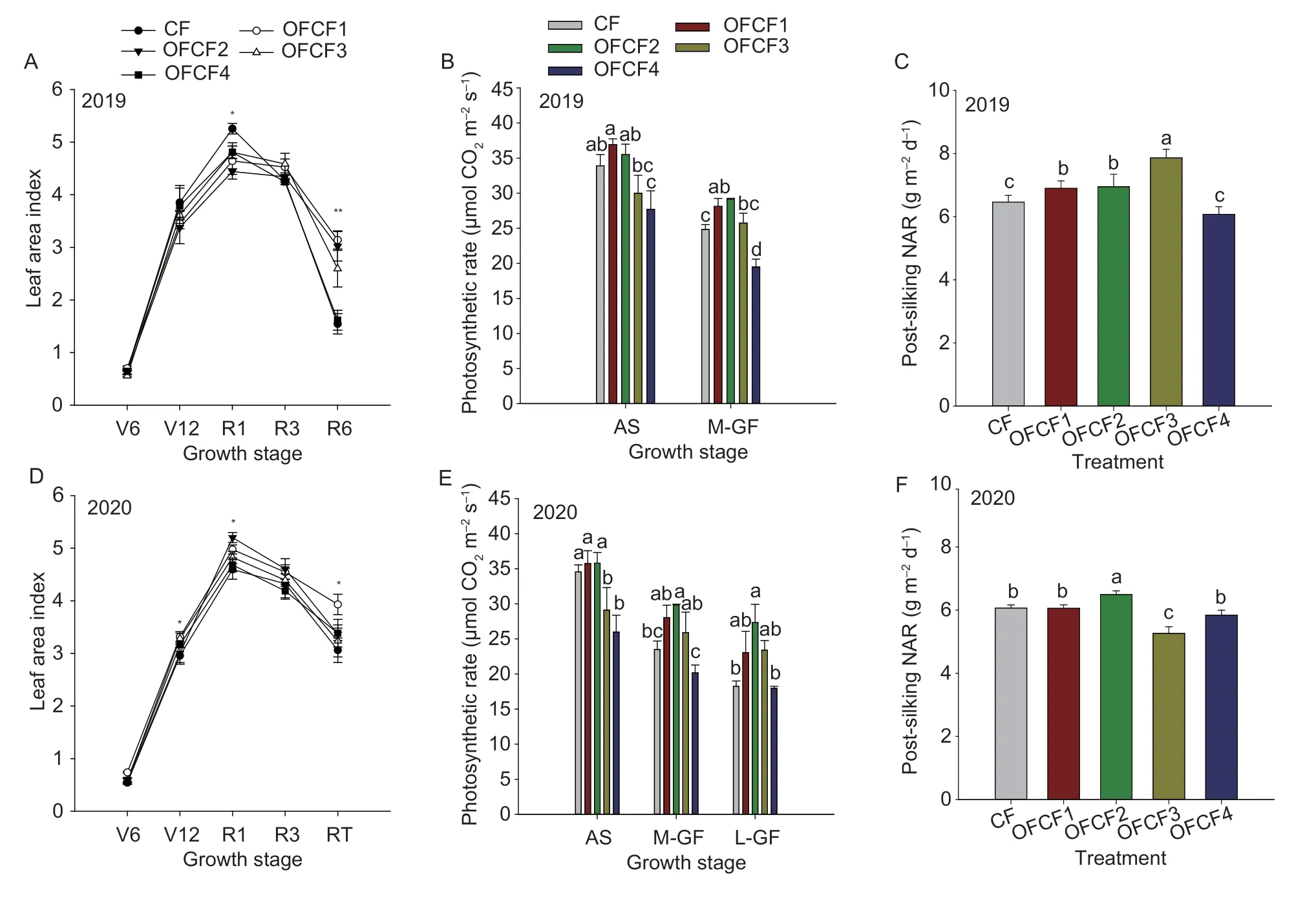
Fig.5 Effects of combined application of organic fertilizer and chemical fertilizer (CAOFCF) on the leaf area index (A and D),photosynthetic rate (B and E),and post-silking NAR (C and F) of summer maize.OF,organic fertilizer;CF,chemical NPK fertilizer;OFCF1,co-application of 15% OF and 85% CF;OFCF2,co-application of 30% OF and 70% CF;OFCF3,co-application of 45% OF and 55% CF;OFCF4,co-application of 60% OF and 40% CF.V6,V12,R1,R3,R6 represent 6-leaf stage,12-leaf stage,silking stage,milking stage,and physiological maturity,respectively.AS,anthesis stage;M-GF,mid-grain filling stage;L-GF,late-grain filling stage.Bars mean SD (n=3).Different lowercase letters above a column indicate significant differences (P<0.05) among treatments.*,P<0.05;**,P<0.01 (significant differences among treatments).
3.5.Post-silking N uptake
Post-silking N uptake was significantly affected by the CAOFCF treatments (Table 2).In the 2019 growing season,the OFCF1,OFCF2,OFCF3,and OFCF4 treatments increased post-silking N uptake by 78.2,111.3,110.9,and 34.5%,respectively,compared with the CF treatment.The contribution of post-silking N uptake to grain N was also significantly greater for the CAOFCF treatments than the CF treatment.In 2020,the postsilking N uptake of OFCF1 and OFCF2 plants increased by 54.4 and 39.7%,respectively,compared with CF plants.However,the OFCF3 and OFCF4 treatments significantly reduced post-silking N uptake.Similarly,the contribution of post-silking N uptake to grain N increased in OFCF1 and OFCF2 plants,but decreased in OFCF3 and OFCF4 plants,compared with CF plants.In addition,the interaction between year and treatment had a significant effect on post-silking N uptake (P<0.01).
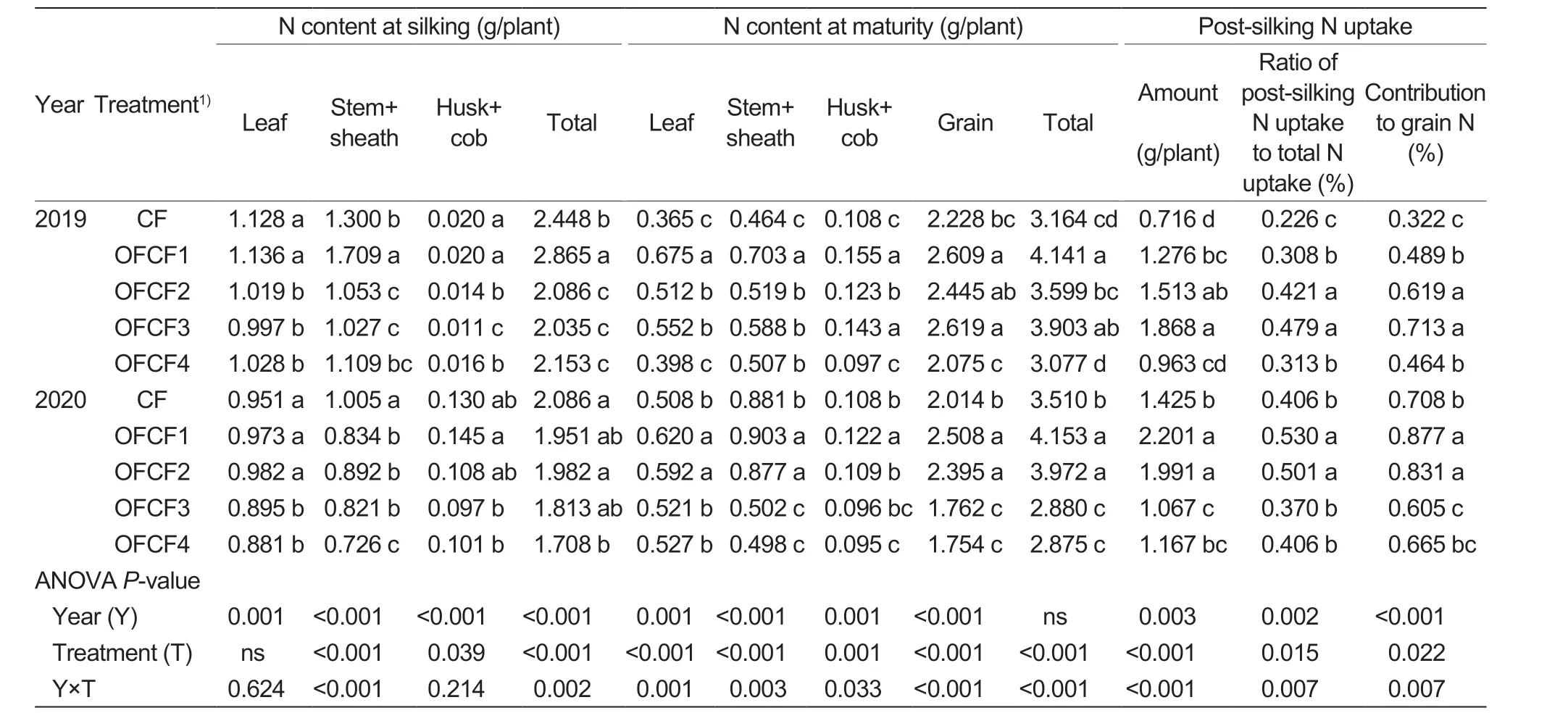
Table 2 Post-silking N uptake and its contributions to grain N in the different treatments
3.6.Plant DMA,grain yield,and yield components
Data for the pre-silking DMA,post-silking DMA,total DMA,and grain yield per unit area are presented in Table 3.Compared with the CF treatment,pre-silking DMA was significantly increased by the OFCF1 treatment (8.42%) but reduced by the OFCF2,OFCF3,and OFCF4 treatments (P<0.05).The OFCF1,OFCF2,and OFCF3 treatments increased post-silking DMA and total DMA by 40.4,33.6,and 44.6% and by 26.1,12.9,and 17.5%,respectively,compared with the CF treatment (P<0.05).However,the OFCF4 treatment significantly reduced post-silking DMA and total DMA,by 8.62 and 8.17%,respectively.The grain yields of OFCF1 and OFCF2 were always significantly higher than those of CF and OFCF4 in both growing seasons.No difference in ear numbers was observed among the treatments,except that OFCF4 was significantly lower than CF in 2019.In both growing seasons,the thousand-kernel weights of OFCF1 and OFCF2 were significantly higher than those of CF,OFCF3,and OFCF4.In 2019,the kernels per ear of OFCF2 was higher than the other treatments,but no significant differences were found among the treatments in 2020.The interaction between year and treatment had no significant effects on pre-silking DMA,post-silking DMA,total DMA,grain yield,or yield components.
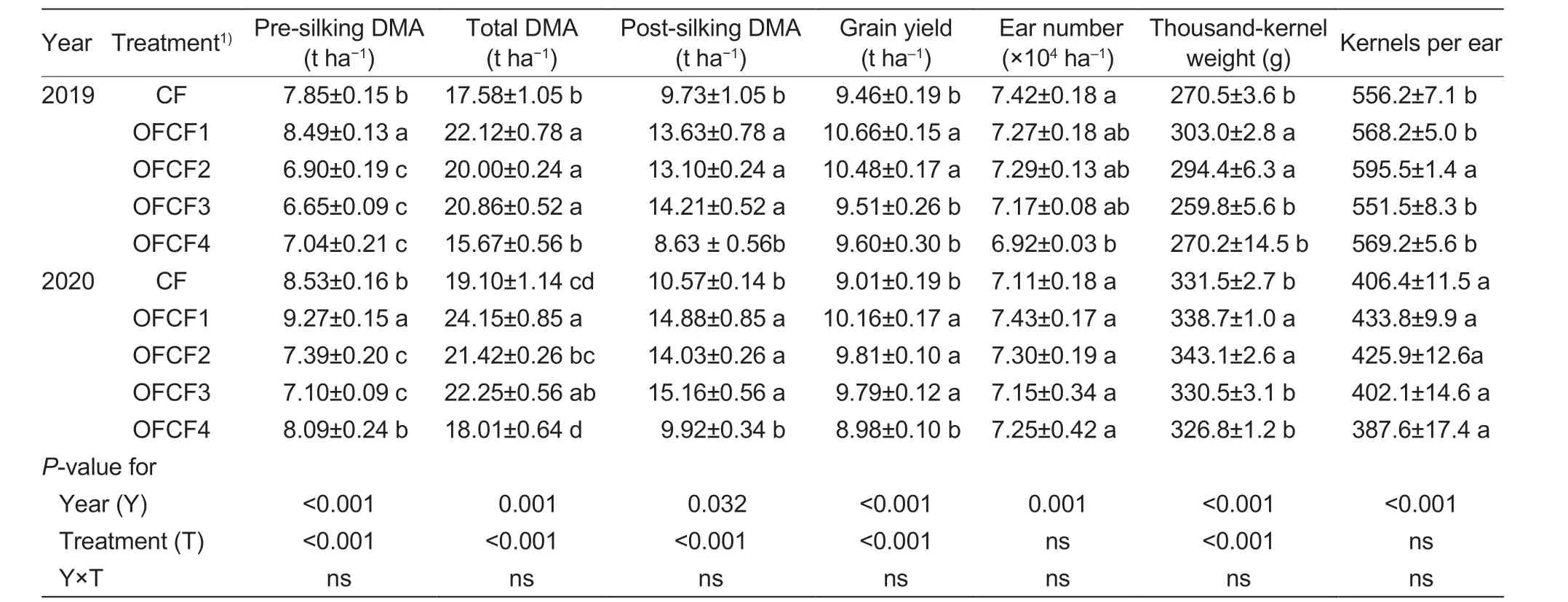
Table 3 Effects of combined application of organic fertilizer and chemical fertilizer (CAOFCF) treatments on dry matter accumulation (DMA),grain yield,and yield components of summer maize
3.7.Root DMA and hormone contents
CAOFCF had a significant effect on root DMA in the 0-40-cm soil layer (P<0.05;Fig.6).In both growing seasons,root DMA values in OFCF1,OFCF2,and OFCF3 plant samples from the 0-10-,10-20-,and 20-40-cm soil layers were greater than root DMA values in the corresponding CF plant samples;and we observed no significant differences between the CF and OFCF4 plant samples.The OFCF1,OFCF2,and OFCF3 treatments increased root DMA in the 0-40-cm soil layer by 27.2,27.3,and 24.7%,respectively,compared with CF.

Fig.6 Effect of combined application of organic fertilizer and chemical fertilizer (CAOFCF) treatment on root dry matter accumulation in different soil layers (0-40 cm).OF,organic fertilizer;CF,chemical NPK fertilizer;OFCF1,co-application of 15% OF and 85% CF;OFCF2,co-application of 30% OF and 70% CF;OFCF3,co-application of 45% OF and 55% CF;OFCF4,co-application of 60% OF and 40% CF.Bars mean SD (n=3).Different letters above the bars within the same soil layer indicate significant differences (P<0.05) among treatments.
Statistical analyses showed that the ZR and ABA contents and ZR/ABA ratio in roots were significantly affected by the CAOFCF treatments (P<0.05;Fig.7).The OFCF1 and OFCF2 treatments increased the ZR contents by 60.9 and 34.6%,respectively,compared with the CF treatment;however,there was little difference in the ZR contents between the CF and OFCF3 plants.ABA content was increased in OFCF1 plants,but reduced in OFCF2 and OFCF3 plants,compared with CF plants.The ZR/ABA ratios were significantly increased in OFCF1 and OFCF2 plants compared with CF plants (P<0.05).

Fig.7 Effect of various combined application of organic fertilizer and chemical fertilizer (CAOFCF) treatments on the zeatin riboside (ZR) (A) and abscisic acid (ABA) (B) contents and ZR/ABA (C) of roots.OF,organic fertilizer;CF,chemical NPK fertilizer;OFCF1,co-application of 15% OF and 85% CF;OFCF2,co-application of 30% OF and 70% CF;OFCF3,co-application of 45% OF and 55% CF;OFCF4,co-application of 60% OF and 40% CF.Bars mean SD (n=3).Different letters above the bars indicate significant differences (P<0.05) among treatments.
3.8.Correlation analysis
As shown in Fig.8,WR was positively correlated with post-silking N uptake and DMA (Fig.8-A,P=0.0392,R2=0.4310;Fig.8-C,P=0.0389,R2=0.3611).By contrast,WG was negatively correlated with post-silking N uptake and DMA (Fig.8-B,P=0.0435,R2=0.4176;Fig.8-D,P=0.0497,R2=0.3250).Similarly,there was a significant positive correlation between grain yield and WR (P=0.04397,R2=0.4295),and grain yield was negatively correlated with WG (P=0.0235,R2=0.3250).

Fig.8 Relationships of weight ratio of inferior to superior kernel (WR) with post-silking N uptake,post-silking dry matter accumulation (DMA),and grain yield (A,C,and E) and relationships of kernel weight gap between superior and inferior kernel (WG) with postsilking N uptake,post-silking DMA,and grain yield (B,D,and F).
4.Discussion
4.1.CAOFCF alleviates the kernel position effect in summer maize
The kernel position effect is common in maize cultivars.However,there are differences in the kernel position effect among maize cultivars (Calvo-Breneset al.2019),which is mainly determined by the genetic characteristics of the cultivars.Alleviating the kernel position effect is important for increasing maize yields (Yang and Li 2012).Generally,inferior kernels are more susceptible to modification than superior kernels (Zhaiet al.2020),and the inferior kernels of maize are more susceptible than superior kernels to abiotic stress during the grain-filling period (Shenet al.2018;Yanet al.2018).Our results showed that,compared with the CF treatment,the OFCF1 and OFCF2 treatments significantly reduced WG and increased WR (Fig.2),suggesting that CA composed of 15-30% OF with 70-85% CF alleviated the kernel position effect in summer maize,largely due to a significant increase in the weight of inferior kernels.Grain filling is known to directly affect the final kernel weights of various cereal crops (Liet al.2020;Zhaiet al.2020;Wuet al.2022).Compared with the CF treatment,the OFCF1 and OFCF2 treatments significantly increased kernel weights by improving the grain-filling rates from 30 DAP (Fig.3).These kernel weight increases were more marked in inferior than superior kernels.Generally,the starch content in maize grains accounts for more than 70% of the total grain weight,and the grain-filling process of maize kernels is mainly a process of starch synthesis and accumulation (Zhanget al.2007;Xuet al.2015).The present results showed that OFCF1 and OFCF2 increased the starch contents in inferior kernels more than in superior kernels (Fig.4-A and C),which implied that OFCF1 and OFCF2 can increase the carbohydrate allocation to inferior kernels compared to CF.Moreover,adequate accumulation of post-silking assimilates is important for grain filling and ensuring normal kernel weight (Wanget al.2021;Li R Fet al.2022;Liu G Zet al.2022).Generally,the assimilate unloading ability of superior kernels is higher than that of inferior kernels (Shenet al.2022),and the sink of superior kernels is larger than that of inferior kernels (Xuet al.2013).These intrinsic characteristics give the superior kernels certain advantages over the inferior kernels in assimilate allocation (Fanet al.2011).When the post-silking assimilate supply is low,inferior kernels cannot obtain sufficient assimilates,which leads to poor grain filling (Yang and Li 2012).In this study,the OFCF1,OFOCF2,and OFCF3 treatments significantly increased post-silking DMA compared with the CF treatment (Table 3),indicating that more post-silking assimilates had accumulated.Therefore,the increases in post-silking assimilate accumulation and the allocation of assimilates to inferior kernels may be the direct reason for the alleviated kernel position effect under the OFCF1 and OFCF2 treatments.
4.2.Effect of CAOFCF on post-silking N uptake in summer maize
Increasing post-silking N uptake by optimizing N fertilizer management can increase maize yields (Chenet al.2022;Guoet al.2022).Recent research has shown that the combined application of organic fertilizer and chemical fertilizer can be an effective strategy for N management,and has been applied to various crops (Zhanget al.2018,2021;Heet al.2022).In this study,the OFCF1 and OFCF2 treatments increased total plant N uptake,mainly due to a significant increase in post-silking N uptake (Table 2).Therefore,substituting 15-30% of the CF with OF containing an equivalent amount of N enhanced postsilking N uptake.Generally,improving soil N availability or reducing N loss can increase plant N uptake (Lianget al.2022).In many studies,CAOFCF either reduced N leaching loss or mitigated reactive N loss (Lvet al.2020;Liuet al.2021;Heet al.2022;Li Y Wet al.2022),suggesting that CAOFCF may increase the N in soil that is available to the plants.Tanget al.(2022) reported that CAOFCF can provide a carbon source for microorganisms that regulate soil N cycling,thereby reducing soil N loss.Therefore,CAOFCF treatments may improve post-silking N uptake partly by reducing the loss of soil N.
Roots are the most important organs involved in crop N uptake,and root size and vigor are important for efficient nutrient uptake (Penget al.2010;Zhang B Cet al.2022).We found that the OFCF1 and OFCF2 treatments significantly increased root DMA (Fig.6).Therefore,OFCF1 and OFCF2 may promote root growth,which is beneficial for plant N uptake (Chenet al.2021;Zhaiet al.2022).Moreover,root cytokinin content is an important physiological index of root senescence (Artner and Benkova 2019),and it is usually negatively correlated with root senescence.At the mid-grain-filling stage,the OFCF1 and OFCF2 treatments in this study significantly increased the root ZR content (Fig.7),indicating that CAOFCF could alleviate post-silking root senescence.However,Liuet al.(2011) found that adding OF had no obvious effect on root senescence in maize.This discrepancy may be explained by the different cropping systems and organic fertilizers used in the two studies.The increased post-silking N uptake exhibited by OFCF1 and OFCF2 plants may be linked to the alleviation of root senescence and improved root growth in summer maize.
4.3.Effect of CAOFCF on the post-silking LAl and photosynthetic capacity of summer maize
Maintaining higher post-silking LAIs and photosynthetic capacity are important for ensuring higher grain yields in maize (Qinet al.2013;Li Y Yet al.2022;Renet al.2022;Yueet al.2022).The OFCF1 and OFCF2 treatments in this study increased post-silking LAIs and reduced the decline of post-silking LAIs (Fig.5-A).These observations are consistent with results reported by Panet al.(2022),and suggest that the OFCF1 and OFCF2 treatments alleviated leaf senescence.Post-silking N uptake is a key factor influencing senescence in maize (Zhanget al.2019).Our results showed that the OFCF1 and OFCF2 treatments increased post-silking N uptake and leaf N content,which is crucial for maintaining higher post-silking LAIs.Because sufficient leaf area is necessary for DMA in maize (Li Y Yet al.2022),the improved post-silking DMA stimulated by the CAOFCF treatments is partly attributable to the higher post-silking LAIs.
Photosynthetic capacity influences assimilate accumulation in maize (Zhaiet al.2020;Yueet al.2022),and post-silking photosynthetic capacity is particularly important for supplying the assimilates used in grain filling (Li R Fet al.2022;Li Y Tet al.2022).The present results showed that the OFCF1 and OFCF2 treatments significantly increased post-silkingPnand NAR (Fig.5-B and C).These findings are consistent with similar studies on wheat (Saikiaet al.2015),and suggest that CAOFCF may improve the post-silking photosynthetic capacity.Meanwhile,these studies showed that the higher photosynthetic capacity under CAOFCF treatment is associated with its role in regulating root growth.Because crop roots and canopy photosynthesis have a mutually beneficial relationship,root growth is closely related to canopy photosynthetic capacity (Yousefzadeh-Najafbadi and Ehsanzadeh 2021).Moreover,adjusting the leaf N content may enhance crop photosynthetic capacity (Fernandezet al.2022;Quet al.2022).Our results showed that the OFCF1 and OFCF2 treatments significantly increased the leaf N contents,compared to that of CF.Given that maize leaf N content is positively correlated with photosynthetic capacity (Zhanget al.2019),the increase in leaf N content may explain the increased photosynthetic capacities of OFCF1 and OFCF2 plants.
4.4.Correlation analysis between kernel position effect and post-silking N uptake,DMA,and grain yield
The correlation analysis revealed that WR was positively correlated with post-silking N uptake and DMA (P<0.05),while WG was negatively correlated with post-silking N uptake and DMA (P<0.05;Fig.8).These findings suggest that the kernel position effect is negatively correlated with post-silking N uptake and DMA.Yang and Li (2012) found that the poor grain filling of inferior kernels,caused by an insufficient supply of assimilates,was the main factor exacerbating the kernel position effect in maize.Therefore,ensuring a sufficient postsilking assimilate supply is the key to alleviating the kernel position effect.Generally,increasing the post-silking N uptake alleviates plant senescence and increases the photosynthetic capacity of maize (Zhanget al.2019),and an increased photosynthetic capacity usually results in greater assimilate accumulation (Li Y Tet al.2022),which is beneficial to grain filling in inferior kernels and alleviates the kernel position effect.Moreover,the results obtained here confirmed that the kernel position effect was negatively correlated with grain yield,which suggested that alleviating the kernel position effect is an important breakthrough for improving the grain yield of summer maize.
5.Conclusion
Our results showed that,compared with the CF treatment,the OFCF1 and OFCF2 treatments alleviated the kernel position effect in summer maize by stimulating grain filling and starch accumulation in inferior kernels.Suppression of the kernel position effect by the OFCF1 and OFCF2 treatments was closely associated with improvements in post-silking N uptake and DMA,which in turn resulted from the robust root system and increased post-silking photosynthetic capacity.Therefore,CA compositions of 15-30% OF and 70-85% CF alleviated the kernel position effect in summer maize by increasing post-silking N uptake and DMA.This combined fertilizer application approach may improve sustainable maize production.
Acknowledgements
This study was financially supported by the HAAFS Science and Technology Innovation Special Project,China (2022KJCXZX-LYS-9),the Natural Science Foundation of Hebei Province,China (C2021301004),and the Key Research and Dvelopment Program of Hebei Province,China (20326401D).
Declaration of competing interest
The authors declare that they have no conflict of interest.
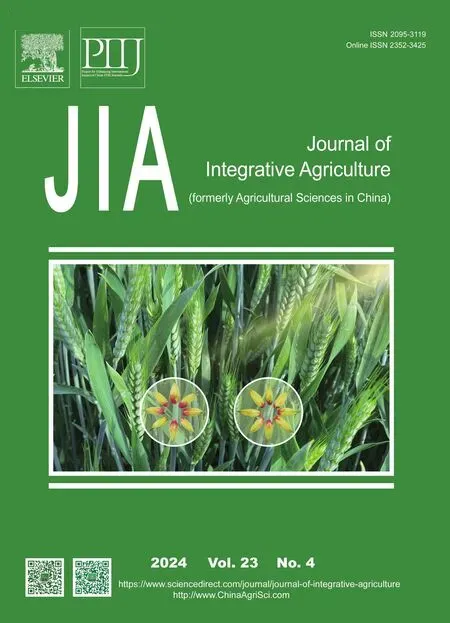 Journal of Integrative Agriculture2024年4期
Journal of Integrative Agriculture2024年4期
- Journal of Integrative Agriculture的其它文章
- OsNPF3.1,a nitrate,abscisic acid and gibberellin transporter gene,is essential for rice tillering and nitrogen utilization efficiency
- Fine mapping and cloning of the sterility gene Bra2Ms in nonheading Chinese cabbage (Brassica rapa ssp.chinensis)
- Basal defense is enhanced in a wheat cultivar resistant to Fusarium head blight
- Optimized tillage methods increase mechanically transplanted rice yield and reduce the greenhouse gas emissions
- A phenology-based vegetation index for improving ratoon rice mapping using harmonized Landsat and Sentinel-2 data
- miR-24-3p promotes proliferation and inhibits apoptosis of porcine granulosa cells by targeting P27
